Europe
Attacking Vuhledar, Russia previews new push to seize southeast Ukraine
The Washington Post February 4, 2023
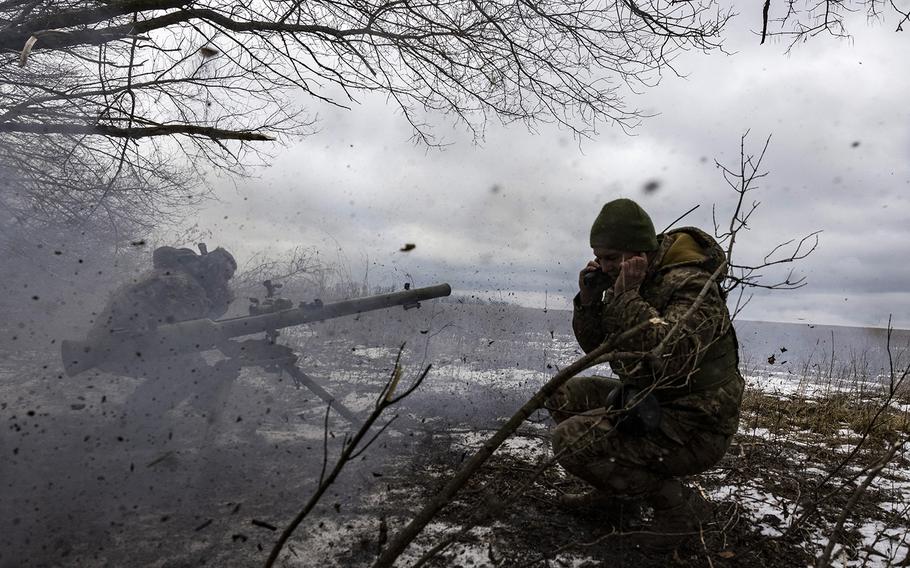
Ukrainian soldiers from the 68th Brigade fire mortars toward Russian positions in a village near the Ukrainian coal-mining city of Vuhledar on Saturday, Feb. 4, 2023. (Heidi Levine for The Washington Post)
BOHOYAVLENKA, Ukraine - Russian forces have launched a midwinter surge of attacks in Ukraine's hotly contested Donetsk region, probing Kyiv's defenses along a fresh stretch of the sprawling eastern front as President Vladimir Putin's commanders ready a new push to conquer all of southeast Ukraine.
The attacks in recent days have centered on Vuhledar, a mostly deserted coal-mining city 70 miles southwest of Bakhmut, where Russian fighters have made some of their first territorial gains in months. Plumes of smoke rise almost constantly from Vuhledar, and the dark woods and rolling fields surrounding the city ring with mortar and artillery volleys from each side.
"They have been pushing hard for last four days, but we have stopped them," said Dykanka, a Ukrainian fighter whom The Washington Post agreed to identify only by his call sign because of security risks.
Amid artillery blasts that shook snow from the bare tree branches, Dykanka, 43, was taking a break along a tank track cut through a forest outside of Vuhledar. An exposed cache of ready 155mm howitzer shells nearby were marked as "ordnance of the U.S. Army."
Vuhledar sits at a crucial bend in the battlefield near where the eastern front meets Russia's line of control to the south, which in turn forms Putin's much-coveted "land bridge" to Crimea from mainland Russia. It is close to a rail line connecting Crimea, a hub for Russian troops and supplies, and the Donbas region.
Dykanka and other fighters said Russian troops have made near daily attempts to overwhelm Ukrainian forces defending Vuhledar and to breach Ukrainian lines extending northwest and southeast of the city.
So far, the Ukrainians have held them off, punching back with artillery, much of it donated by Western allies, machine gun fire and improvised bombs dropped by drones.
But as the first anniversary of the invasion approaches, and Moscow deploys tens of thousands of reinforcements to the front, military analysts and soldiers on the battlefield say the momentum seized last autumn by Ukraine in two major counteroffensives has stalled.
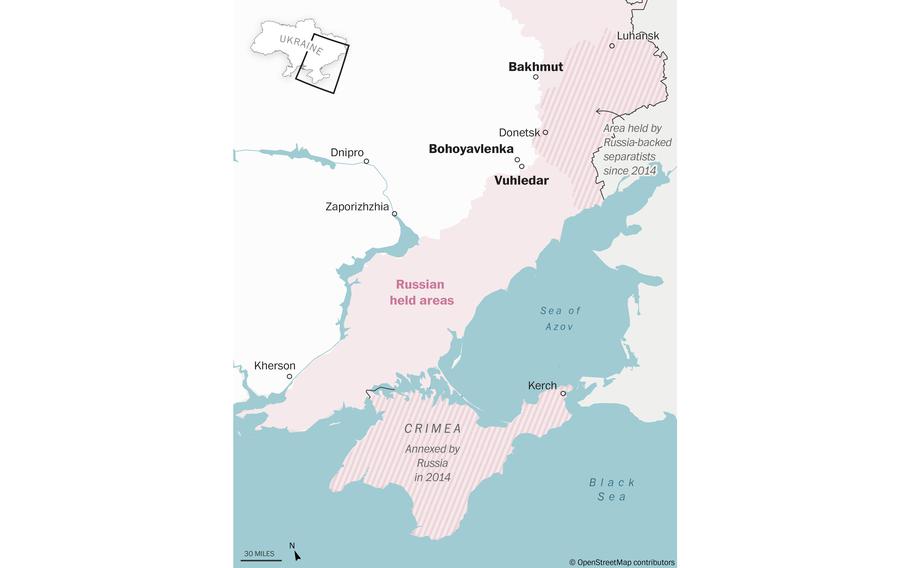
()
And near Vuhledar, at least, the initiative has even shifted incrementally back to the enemy, they say.
"You can feel the intensity building in the last week," said Andrii, a machine-gunner who had just come off a five-day stint outside of Vuhledar where he slept in a log-covered trench when not keeping his mounted Browning trained on Russian positions.
"We are more in a defensive position," Andrii said. "We are not making gains from here."
Further north near Bakhmut, a months-long onslaught led by Wagner mercenaries helped Russia capture the salt-mining town of Soledar, and the Kremlin's forces are now poised to seize control of the city. Near Vuhledar, they have gained no significant ground since November when Russian forces retook Pavlivka, a village just to the south, that has changed hands more than once since the invasion almost a year ago.
But in a recent interview with The Washington Post, Ukraine's military intelligence chief, Maj. Gen. Kyrylo Budanov, said there are now more 320,000 Russian soldiers in Ukraine - more than double Moscow's estimated initial invasion force of 150,000. Ukraine, in turn, faces an acute need of more soldiers and weapons.
Putin has insisted that Russia will achieve its war goals, including in a speech last week celebrating the Soviet Union's victory over Germany in the Battle of Stalingrad. And his newly installed commander, Gen. Valery Gerasimov, said last month that Russia's positioning in Ukraine had stabilized enough for forces to concentrate "on completing the liberation of the territory of the Donetsk People's Republic."
Donetsk is one four regions of southeast Ukraine, along with Luhansk, Kherson and Zaporizhzhia, that Putin has claimed, illegally, to have annexed, despite not controlling them militarily or politically.
Ukrainian military officials, and outside military experts, however, say that Russia may not be able to capitalize on the advantage of its force size.
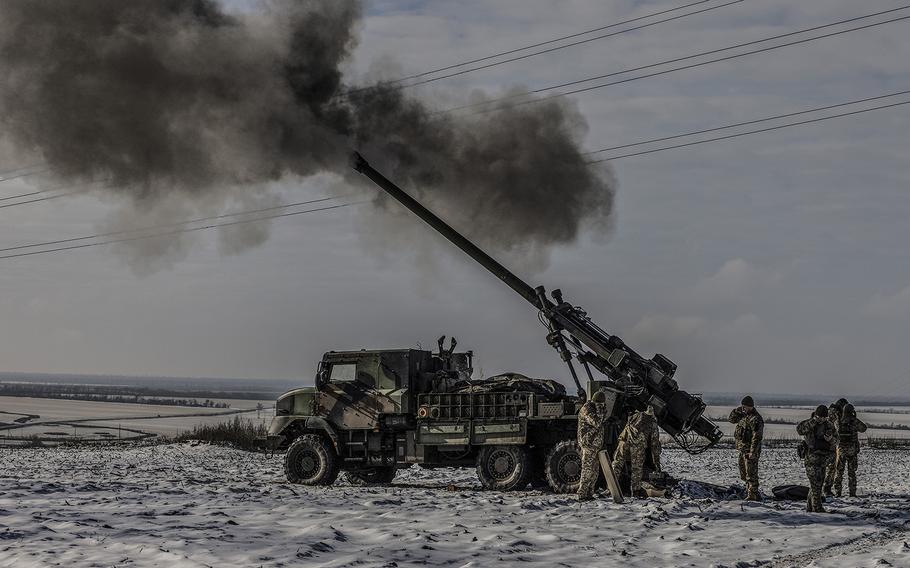
Ukrainian soldiers fire French-made Caesar howitzers at Russian forces near Vuhledar on Friday, Feb. 3, 2023. (Heidi Levine for The Washington Post)
Troop shortages, command failures and, more recently, dwindling munitions have hampered the invaders from taking advantage of costly conquests early in the war, of cities like Lysychansk in Luhansk region.
"At first, they had the equipment but they didn't have the men. Now they have the men, but they don't have the equipment," said Konrad Muzyka, a defense analyst and director at Rochan Consulting, based in Poland.
Western weapons have further disrupted Russia's usual military doctrine of massing a preponderance of troops and weapons to pierce the enemy line and then advance deeper into enemy territory, Muzyka said. The U.S.-supplied HIMARS (high mobility artillery rocket system), which was deployed in Ukraine last summer and uses GPS-guided munitions, has proved particularly effective at targeting that kind of concentration of forces.
Muzyka and other military experts say a victory over Vuhledar and its environs, on its own, would have limited military value for Moscow - a point they have similarly made about Bakhmut. "If Vuhledar falls, it will be a minor tactical victory at best," he said.
But every captured city, large or small, represents a step toward Putin's goals. And in Moscow, where military officials have faced withering criticism from pro-war hawks over its military defeats so far, there is mounting pressure for victories, even symbolic ones.
Many Ukrainians fighting here believe that is precisely what Russia is after.
"Vuhledar is not a strategic priority in military terms, but it is a strategic priority for Russian propaganda," said Oleksii Dmytrashkivskyi, the military spokesman for the Donetsk and Zaporizhzhia regional government.
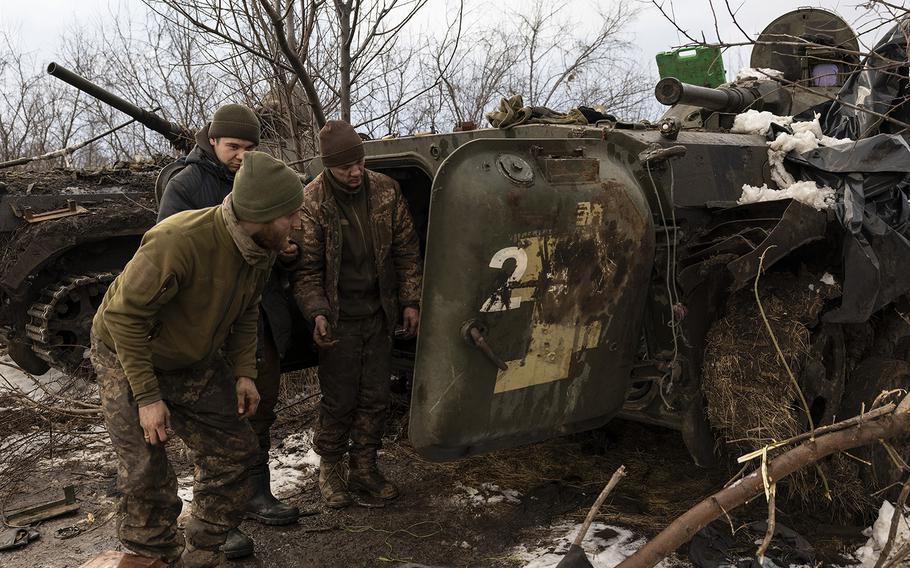
Sasha, left, and other Ukrainian soldiers work to repair their broken down armored personnel carriers on the outskirts of Vuhledar on Thursday, Feb. 2, 2023. (Heidi Levine for The Washington Post)
The forces fighting for Vuhledar, according to analysts, are mostly naval infantry troops from Russia's 155th Brigade of the Pacific Fleet, forces akin to U.S. Marines. Their presence sets up a rematch of sorts between the Ukraine's 72nd Mechanized Brigade, which has forces deployed in the area. The 72nd faced and largely bested the 155th in the fighting around Kyiv in the early weeks of the invasion.
Dykanka, the soldier resting in the woods, said his side relished a second meeting. "There are already a lot of dead Russians over there," he said. "We're just waiting for them to bring in fresh meat."
While the skirmishes here are numerous and aggressive, including 13 separate attempts to puncture Ukrainian defenses on Wednesday night, they do not indicate that a major force is gathering - at least not yet.
Intelligence estimates suggest Russia has about six battalion tactical groups in rotation around Vuhledar, about half or fewer than a major operation would require, according to Muzyka.
Instead, Russia may be trying to force Ukraine to divert troops from Bakhmut and other hot zones to Vuhledar. Or they may be testing Ukrainian strength at different points along the 140-mile front line that stretches through Donetsk and Luhansk. Or possibly mounting a diversionary tactic for an offensive planned for another area entirely. Or a combination of all of these.
"It's hard to know where we are in the movie," said Dara Massicot, a policy researcher at Rand Corp., when asked about the prospects for a major new offensive. "Clearly, there has been a directive to make progress. But I don't see signs that the force is ready."
"He is commanding the forces to do more than they are capable of doing," Massicot added, speaking of Putin. "That could be a preview of the way they handle a new offensive."
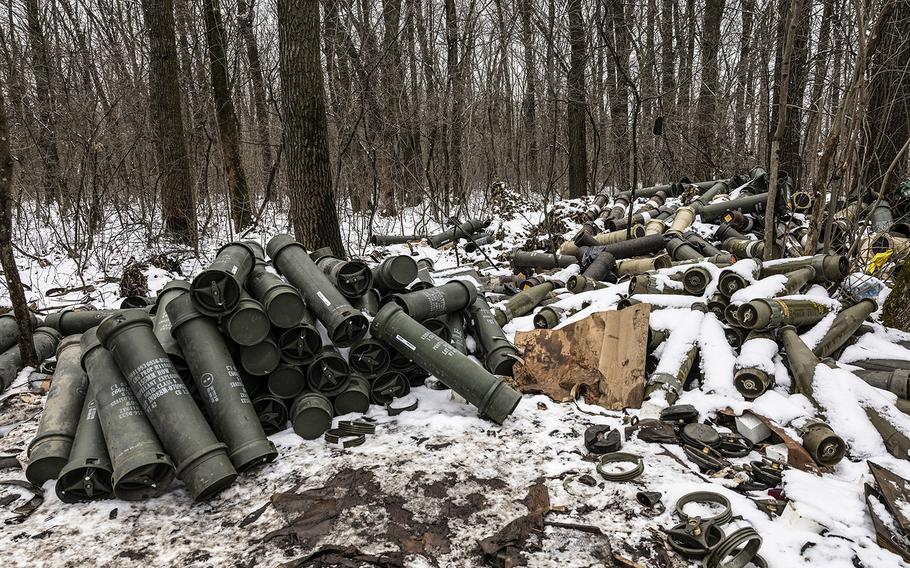
A cache of ready 155mm howitzer shells in the forest near Vuhledar on Thursday, Feb. 2, 2023. (Heidi Levine for The Washington Post)
For civilians in the area, Russia's motives are less important than the crushing upheaval the fighting has imposed on their daily lives. Thousands of residents have fled from the surrounding villages, leaving abandoned houses for sheltering soldiers and dogs roaming for food in the snow. Many of those remaining are elderly. The small city has been devastated by the fighting, with destroyed buildings on nearly every block, according to a Ukrainian platoon leader who was in Vuhledar this week.
Even the humanitarian volunteers have stopped coming in recent days, according to Valentyna Kalitch, 70, who was walking in her village of Katerynivka. The house, which a passing Ukrainian fighter said was a "tank shot" from the nearest Russian position, has been struck repeatedly.
"It is scariest at night," Kalitch said, setting down the bucket of red winter berries she uses to make blood pressure medicine. "We just sit in the hallway and pray it doesn't hit us again."
In the meantime, Ukrainian forces say they continue to hold their own around Vuhledar.
At an unused government building serving as a fallback base several miles to the north, one platoon rested on a recent night after a series of deployments by reviewing video of their attacks, like a sports team watching replays.
"That one was too far," a soldier said as drone footage on widescreen television showed a howitzer shell hitting behind a tree line. The unit's reconnaissance drones had directed the targeting to Russian hiding place. A second shot also missed. "That was too close."
Then, there was a third. "Boom," he shouted as a plume of smoke, dust and military equipment exploded on screen and the room erupted in cheers.